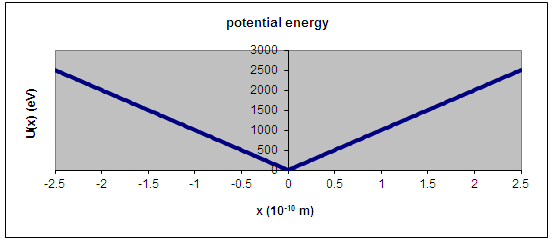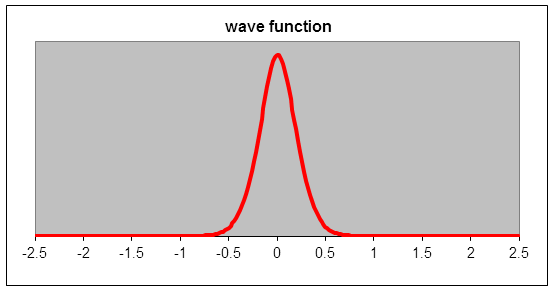Other 1D potentials
Problem:
A particle confined by a potential energy function which is given by
U(x) = c|x|, as shown below.

The energy of the ground state is E0 ~160 eV. The energy of the
6th excited state is E6 ~960 eV.
The ground state wave function is shown.

Sketch the wave function of the sixth excited state. Pay attention to the
symmetry, the number of nodes, the wavelength, the amplitude and the boundary
condition. Briefly defend your sketch.
Solution:
- Concepts:
The 1D time-independent Schroedinger equation.
- Reasoning:
The wave function of the 6th excited state has 6 nodes. It is
symmetric under reflection about the origin. The classical
turning points are where U(x) = 960 eV, at |x| somewhere between 0.9 and 1
Angstrom. For |x| < xturning point the wave function
oscillates. Near x = 0 the wave function oscillates rapidly since k is
large. Near the turning points it oscillates less rapidly since k is much
smaller. The amplitude increases as we approach the turning points.
For |x| > xturning point the wave decreases rapidly.
- Details of the calculation:

Problem:
Assume that a certain one-dimensional well has just one bound
state for an electron. Now assume that a 1D "crystal" consist of an "infinite"
series of such wells, evenly spaced by a distance b.
Let {|n>} be the orthonormal eigenstates of some operator (not the Hamiltonian)
that finds the electron located in the nth well, n = -∞ to +∞.
Let us restrict ourselves to the subspace spanned by {|n>}.
Assume that in this basis the matrix elements of the Hamiltonian are given by
<n|H|n> = E0, <n|H|m> = -Aδm,n±1, i.e. H only couples
neighboring state, the electron can move from one well to the next.
(a) Assume the eigenstates of H are of the form |Φ> = ∑n a(xn)|n>.
Write down the coupled linear equations for the a(xn). Note that a(xn±1)
= a(xn ± b).
(b) Try solutions of the form a(xn) = exp(ikxn) and solve
for E as a function of k.
Sketch E(k). Explain why you only need to consider -π/b ≤ k < π/b.
What is the range of possible eigenvalues of H?
(c) The solutions |Φ> = ∑n exp(ikxn)|n> with eigenvalues
E(k) are stationary states. A wave packet with a range of k-values about some k0
can represent an electron moving through the "crystal". Find the group velocity
of such a wave packet.
(d) Expand E(k) about k at its minimum value Emin, keeping terms up
to second order in k.
Expand vg about the same value of k.
Set E(k) - Emin = ½ m*vg2 and find the
effective mass m* of the electron in the crystal near the minimum of the energy
band.
Show that m* = ħ2(d2E/dk2)-1.
(e) Find the effective mass of the electron in the crystal near the maximum of
the energy band.
Solution:
- Concepts:
Electrons in a periodic structure
- Reasoning:
We are asked to solve coupled eigenvalue equations.
- Details of the calculation
(a) <m|H|Φ> = ∑n a(xn) <m|H|n> .
Ea(xm) = E0a(xm) - Aa(xm+1) - Aa(xm-1)
= E0a(xm) - Aa(xm + b) - Aa(xm - b).
(b) Eexp(ikxn) = E0expik(xn) - Aexp(ik(xn+b))
- Aexp(ik(xn-b)) .
E = E0 - Aexp(ikb) - Aexp(-ikb)) = E0 - 2Acoskb.
We only need to consider -π/b ≤ k < π/b because k values differing by π/b give
the same coefficients.
The possible eigenvalues of H lie in a band from E0 - 2A to E0
+ 2A.
(c) vg = dω/dk|k0 = (1/ħ)dE/dk|k0 =
(2Ab/ħ)sin(k0b).
(d) An expansion of E(k') about k' = 0 for k' = 0 + k yields E(k) = E0 - 2A + Ak2b2
= Emin + Ak2b2.
An expansion of vg(k') about
k' = 0 for k' = 0 + k yields 2Ab2k/ħ.
E(k) - Emin = Ak2b2 = ½ m*(2Ab/ħ)2k2b2,
m* = ħ2/(2Ab2).
d2E/dk2 = 2Ab2. ħ2(d2E/dk2)-1
= ħ2/(2Ab2) = m*.
[For a free wave packet: vg = dE/dp =
ħ-1(dE/dk), a = dvg/dt = ħ-2(d2E/dk2)d(ħk/dt)
= F/m.
But F = dp/dt = d(ħk/dt). Therefore m = ħ2(d2E/dk2)-1.]
(e) And expansion about k' = π/b for k' = π/b - k yields E(k) = E0 + 2A - Ak2b2
= Emax - Ak2b2.
Using m* = ħ2(d2E/dk2)-1
we find m* = -ħ2/(2Ab2).
Note dvg/dt = Fext/m*. If an external force is applied,
the electron in a crystal is subject to this force and internal forces from the
lattice. The net force may point opposite to the external force.


